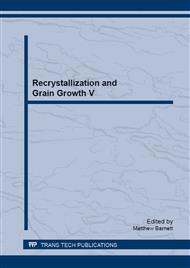p.107
p.113
p.117
p.121
p.125
p.131
p.137
p.143
p.147
Disconnection Motion in Low- and High-Angle Symmetrical Tilt Grain Boundaries in HCP Metal
Abstract:
The structure of disconnections in symmetrical low- and high-angle [0001] tilt boundaries in an hcp metal are studied using atomic-scale simulation. Applied engineering strains cause such defects to move conservatively along the boundaries, producing coupled shear and migration. The Peierls stresses causing such motion are found to decrease precipitously through the transition from low- to high-angle boundaries. The reason underlying this behaviour is discussed.
Info:
Periodical:
Pages:
125-130
Citation:
Online since:
March 2013
Authors:
Price:
Сopyright:
© 2013 Trans Tech Publications Ltd. All Rights Reserved
Share:
Citation:


